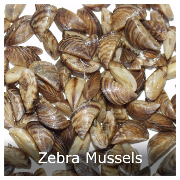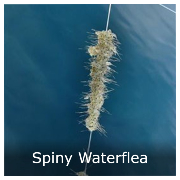With over 800 lakes and ponds throughout Vermont, and 100 of those infested with aquatic invasive species, the Vermont Department of Environmental Conservation (VTDEC) staff annually monitor and survey priority lakes and ponds along with aquatic invasive species (AIS) considered a severe threat. During the growing season, VTDEC staff routinely survey and monitor Vermont waters to:
- Check for and document infestations of aquatic nuisance species in new waterbodies
- Evaluate population status of existing infestations and their impacts on aquatic native species
- Determine best management and control efforts that may be used on existing infestations
- Assess habitat suitability of waters to determine risk of a possible invasive infestation
Zebra Mussel Monitoring
The Lake Champlain Basin Program, in cooperation with VTDEC initiated the Lake Champlain Zebra Mussel Monitoring Program in 1994 to track the zebra mussel's districbution through th elake, Information on veliger and juvenile densities monitored consistently since the initial colonization is obtained concurrently with comprehensive water quality data. This information is critical to determining the effects of zebra mussels on the Lake Champlain ecosystem and the potential risk and impact of zebra mussel colonization of other water bodies. VTDEC staff also conducts annual sureys in non-Lake Champlain waterbodies throughout Vermont that are at risk for a zebra mussel introduction.
Spiny Waterflea Monitoring
Due to the discovery of Spiny Waterflea in Lake Champlain in 2014, VTDEC staff routinely monitor for new infestations of the invasive zooplankton. Since 2015, no new infestations have been discovered in other non-Lake Champlain waterbodies. The Fish Hook Waterflea, a related species, was discovered in 2018 in Lake Champlain, and is also monitored equally.
Water Chestnut Monitoring
In addition to the extensive Water Chestnut management efforts, annual surveys are conducted on waterbodies where water chestnur was eradicated, and waterbodies that are at a higher risk for an introduction of the species.
Aquatic Macrophyte Monitoring
The Aquatic Macrophyte Monitoring Program collects baseline information on aquatic plant communities in Vermont lakes by conducting descriptive surveys using a pre-established plant cover scale. These efforts also track rare, threatened and endangered aquatic plants; information that is shared with the Department of Fish and Wildlife's Heritage Program. This monitoring program has been active since the late 1970s, and discrete survey information is available.
Other Resources
List of Waterbodies in Vermont Infested with an Invasive Species
Map of major AIS infestations within Vermont
Vermont Lakes Scorecard (maintains a "score" for aquatic invasive species)
You can help monitor Vermont waters for invasive species: Become a Vermont Invasive Patroller
or a Vermont Invasive Patroller for Animals.

